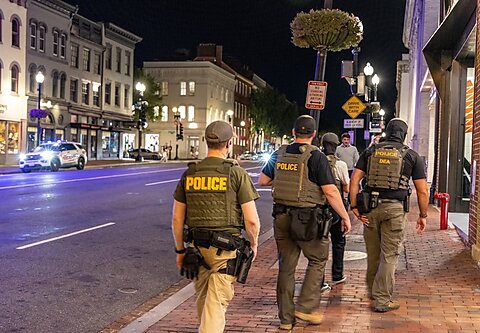
Mike Fox
As a DC resident and former public defender in a crime-plagued city, I’ve witnessed the devastating effects of violent crime firsthand. In January 2024, a horrendous act of violence came to my front door. Upon returning from a brisk dog walk, I learned that my Northeast DC street had become a crime scene. A man had been carjacked and gunned down on a busy street corner in broad daylight. Random acts of violence like this make me uneasy, knowing the victim could just as easily have been me or someone I knew and cared about. These horrific narratives have become far too common, and those responsible must be held accountable. Everyone, from residents to workers to tourists, deserves to feel safe in the District.
Similarly, our capital city should be a symbol of freedom to the rest of the world. A city under siege by soldiers and federal agents dressed in military fatigues—reminiscent of an authoritarian regime—undermines the very proposition upon which this nation was founded.
DC is not only our nation’s capital but also home to roughly 700,000 residents—who are worthy of dignity and respect. Much like any other major city, some crime is inevitable. While violent crime in DC has dropped considerably following a recent spike, there’s still much work to be done. One thing is clear, however: There is no crime crisis necessitating President Trump to declare a “public safety emergency.” Yet this strategy of deploying federal law enforcement assets in a bizarre and often extra-constitutional fashion is nothing new for the Trump regime.
Earlier this year, in an effort to meet self-imposed quotas, Trump ordered immigration agents, who should be pursuing violent offenders, to indiscriminately target people who look “illegal.” Now he’s reassigned FBI agents who should be doing counterterrorism or countersurveillance work to foot patrols in DC to quell disorder.
Crime is a complex issue. And confronting it head-on requires an honest and transparent approach. Flooding tourist areas like the National Mall and Georgetown, not known to be hotbeds for crime, isn’t a productive use of federal resources. Likewise, arresting homeless people for trivial public order offenses won’t curtail violent crime. The criminal justice system should be a last resort, used to incapacitate those who tear at the very fabric of civil society. Truly violent offenders must be locked away for a long time to protect the community. Unfortunately, our current system doesn’t do a very good job at this.
In DC, the clearance rates for violent crimes are disturbingly low. Last year, only 60 percent of murders in the District were “cleared” with an arrest—not necessarily a conviction. For robberies, the rate was just 34 percent, and for non-fatal shootings, it was a mere 31 percent. This means that a large number of violent criminals aren’t being caught, leaving them free to reoffend. It’s no secret that understaffed police forces can lead to serious crimes going unsolved. But so too can distorted policing priorities. More officers on the beat doesn’t necessarily imply a reduction in violent crime. How officers interface with the communities they serve tells us far more than the size of the force ever will.
While there’s been much discourse regarding the role of DC’s recent criminal justice reforms, the most effective crime deterrent isn’t the length of a sentence but rather the certainty of being caught and swiftly punished. When so many violent crimes go unsolved, the conversation about sentencing loses its impact.
As a federal enclave, DC is unique. The US Attorney’s Office prosecutes both federal crimes and local adult felonies. This arrangement means that the US Department of Justice, not the DC Government, has the primary responsibility for prosecuting violent crime in the District. A serious approach to prosecuting violent crime starts by putting serious people in charge. But in an administration that prioritizes loyalty above all else, this may be hard to come by.
To add another layer of complexity, the DC attorney general (AG) is tasked with prosecuting all misdemeanors and juvenile felony cases. The DC AG’s juvenile docket contains everything from truancy cases to homicides. Accordingly, it’s clear why a one-size-fits-all approach won’t suffice. Ideally, the juvenile justice system ought to operate with an eye towards rehabilitation. However, in instances of extreme violence where community safety is on the line, restoration may not be feasible, and the role must shift towards one of incapacitation. In such instances, the law confers upon the US attorney the ability to directly charge 16- and 17-year-olds in Superior (adult) Court without judicial authorization. Whether this carveout should be expanded merits debate.
When violent offenders aren’t held sufficiently accountable, the fault often lies not with the law itself, but with those charged with enforcing it. In a system where often highly coercive plea bargaining has displaced the constitutionally prescribed mechanism by which we adjudicate criminal cases—the jury trial—it’s worth asking how many violent offenders who are caught are getting light sentences as a result of generous plea deals.
We can’t arrest our way out of crime. Curbing violent crime necessitates making fewer, higher-quality arrests. Taking a step back and only intervening where absolutely necessary would foster a crucial sense of trust between the police and the communities they serve. On the contrary, embedding heavily armed and wholly unaccountable federal agents in our neighborhoods erodes this trust. Without community cooperation, it’s nearly impossible to secure the convictions needed to take violent offenders off the streets for prolonged periods of time. While an easy arrest for a low-level offense might boost statistics, it does nothing to reduce violent crime and only deepens public distrust.
The criminal justice system must be even-keeled. As the US Park Police arrest homeless people for drinking in public or smoking marijuana in Dupont and Logan Circles, they wouldn’t dare do the same to the wealthier folks who picnic in those parks on the weekends, sipping wine and White Claws. The system should be a tool for public safety, not a way to selectively punish some people while ignoring others who commit the same offenses.
Residents of high-crime areas want to feel safe and understand the vital role local police play in that. They want to trust the officers in their community and know that to resolve violent crime, that trust has to be mutual. Police and communities should be partners. But when conduct that poses no genuine harm to others is met with an iron fist, the relationship becomes adversarial. People in crime-plagued communities don’t want to defund the police or abolish prisons. Reasonable people want common sense to prevail. They yearn for effective, accountable policing and a system that prioritizes their safety without turning their neighborhoods into occupied zones under constant surveillance.
To the extent federal intervention is warranted, a serious attempt to stem the tide might involve supporting DC’s detectives in their quest to identify perpetrators of violent crimes or bolstering the ranks of the US Marshal’s Capital Area Regional Fugitive Task Force, which is tasked with taking violent offenders off the streets. But as evident from recent violent crimes, including an August 10 homicide in Logan Circle—in which no arrest has been made—haphazardly flooding the streets with federal agents and National Guard troops does little to prevent brazen crime or bring closure to victims.
Of course, just as the president has deprioritized targeting violent offenders for deportation, this effort isn’t about arresting violent offenders or enhancing the public safety of DC residents and visitors. Instead, as apparent from President Trump’s patently unconstitutional tariffs, this “emergency declaration” is Trump’s latest power grab. Anyone with the most basic awareness of community policing would understand that employing federal agents to randomly accost and threaten residents on their front porch doesn’t engender the trust needed to make DC a safer city.
Meaningful solutions won’t come from MAGA talking points. Just as they won’t come from prison abolitionists, who live in some utopian crime-free universe. Rather, the answer lies in fostering the level of community trust needed to solve violent crime. And this involves confronting the difficult reality that more of the same isn’t the answer.






